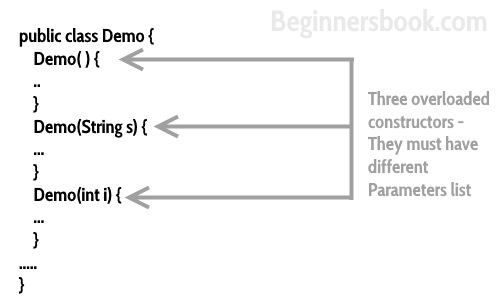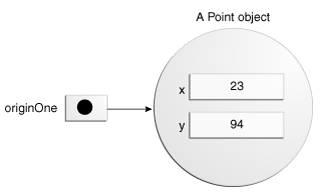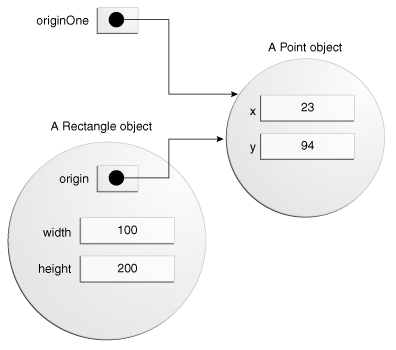Constructor Overloading in Java with examples 构造方法重载 Default constructor 默认构造器 缺省构造器 创建对象 类实例化
Providing Constructors for Your Classes (The Java™ Tutorials > Learning the Java Language > Classes and Objects) https://docs.oracle.com/javase/tutorial/java/javaOO/constructors.html
A class contains constructors that are invoked to create objects from the class blueprint. Constructor declarations look like method declarations—except that they use the name of the class and have no return type. For example, Bicycle has one constructor:
Constructor Overloading in Java with examples https://beginnersbook.com/2013/05/constructor-overloading/

Constructor overloading is a concept of having more than one constructor with different parameters list, in such a way so that each constructor performs a different task. For e.g. Vectorclass has 4 types of constructors. If you do not want to specify the initial capacity and capacity increment then you can simply use default constructor of Vector class like this Vector v = new Vector(); however if you need to specify the capacity and increment then you call the parameterized constructor of Vector class with two int arguments like this: Vector v= new Vector(10, 5);
You must have understood the purpose of constructor overloading. Lets see how to overload a constructor with the help of following java program.
Constructor Overloading Example
Here we are creating two objects of class StudentData. One is with default constructor and another one using parameterized constructor. Both the constructors have different initialization code, similarly you can create any number of constructors with different-2 initialization codes for different-2 purposes.
StudentData.java
class StudentData
{
private int stuID;
private String stuName;
private int stuAge;
StudentData()
{
//Default constructor
stuID = 100;
stuName = "New Student";
stuAge = 18;
}
StudentData(int num1, String str, int num2)
{
//Parameterized constructor
stuID = num1;
stuName = str;
stuAge = num2;
}
//Getter and setter methods
public int getStuID() {
return stuID;
}
public void setStuID(int stuID) {
this.stuID = stuID;
}
public String getStuName() {
return stuName;
}
public void setStuName(String stuName) {
this.stuName = stuName;
}
public int getStuAge() {
return stuAge;
}
public void setStuAge(int stuAge) {
this.stuAge = stuAge;
} public static void main(String args[])
{
//This object creation would call the default constructor
StudentData myobj = new StudentData();
System.out.println("Student Name is: "+myobj.getStuName());
System.out.println("Student Age is: "+myobj.getStuAge());
System.out.println("Student ID is: "+myobj.getStuID()); /*This object creation would call the parameterized
* constructor StudentData(int, String, int)*/
StudentData myobj2 = new StudentData(555, "Chaitanya", 25);
System.out.println("Student Name is: "+myobj2.getStuName());
System.out.println("Student Age is: "+myobj2.getStuAge());
System.out.println("Student ID is: "+myobj2.getStuID());
}
}
Output:
Student Name is: New Student
Student Age is: 18
Student ID is: 100
Student Name is: Chaitanya
Student Age is: 25
Student ID is: 555
Let’s understand the role of this () in constructor overloading
public class OverloadingExample2
{
private int rollNum;
OverloadingExample2()
{
rollNum =100;
}
OverloadingExample2(int rnum)
{
this();
/*this() is used for calling the default
* constructor from parameterized constructor.
* It should always be the first statement
* inside constructor body.
*/
rollNum = rollNum+ rnum;
}
public int getRollNum() {
return rollNum;
}
public void setRollNum(int rollNum) {
this.rollNum = rollNum;
}
public static void main(String args[])
{
OverloadingExample2 obj = new OverloadingExample2(12);
System.out.println(obj.getRollNum());
}
}
Output:
112
As you can see in the above program that we called the parameterized constructor during object creation. Since we have this() placed in parameterized constructor, the default constructor got invoked from it and initialized the variable rollNum.
Test your skills – Guess the output of the following program
public class OverloadingExample2
{
private int rollNum;
OverloadingExample2()
{
rollNum =100;
}
OverloadingExample2(int rnum)
{ rollNum = rollNum+ rnum;
this();
}
public int getRollNum() {
return rollNum;
}
public void setRollNum(int rollNum) {
this.rollNum = rollNum;
}
public static void main(String args[])
{
OverloadingExample2 obj = new OverloadingExample2(12);
System.out.println(obj.getRollNum());
}
}
Output:
Exception in thread "main" java.lang.Error: Unresolved compilation
problem:Constructor call must be the first statement in a constructor
Program gave a compilation error. Reason: this() should be the first statement inside a constructor.
Another Constructor overloading Example
Another important point to note while overloading a constructor is: When we don’t implement any constructor, the java compiler inserts the default constructor into our code during compilation, however if we implement any constructor then compiler doesn’t do it. See the example below.
public class Demo
{
private int rollNum;
//We are not defining a no-arg constructor here Demo(int rnum)
{
rollNum = rollNum+ rnum;
}
//Getter and Setter methods public static void main(String args[])
{
//This statement would invoke no-arg constructor
Demo obj = new Demo();
}
}
Output:
Exception in thread "main" java.lang.Error: Unresolved compilation
problem:The constructor Demo() is undefined
Creating Objects
Creating Objects (The Java™ Tutorials > Learning the Java Language > Classes and Objects) https://docs.oracle.com/javase/tutorial/java/javaOO/objectcreation.html
The Java Tutorials have been written for JDK 8. Examples and practices described in this page don't take advantage of improvements introduced in later releases.
Creating Objects
As you know, a class provides the blueprint for objects; you create an object from a class. Each of the following statements taken from the CreateObjectDemo program creates an object and assigns it to a variable:
Point originOne = new Point(23, 94);
Rectangle rectOne = new Rectangle(originOne, 100, 200);
Rectangle rectTwo = new Rectangle(50, 100);
The first line creates an object of the Point class, and the second and third lines each create an object of the Rectangle class.
Each of these statements has three parts (discussed in detail below):
- Declaration: The code set in bold are all variable declarations that associate a variable name with an object type.
- Instantiation: The new keyword is a Java operator that creates the object.
- Initialization: The new operator is followed by a call to a constructor, which initializes the new object.
Declaring a Variable to Refer to an Object
Previously, you learned that to declare a variable, you write:
type name;
This notifies the compiler that you will use name to refer to data whose type is type. With a primitive variable, this declaration also reserves the proper amount of memory for the variable.
You can also declare a reference variable on its own line. For example:
Point originOne;
If you declare originOne like this, its value will be undetermined until an object is actually created and assigned to it. Simply declaring a reference variable does not create an object. For that, you need to use the new operator, as described in the next section. You must assign an object to originOne before you use it in your code. Otherwise, you will get a compiler error.
A variable in this state, which currently references no object, can be illustrated as follows (the variable name, originOne, plus a reference pointing to nothing):

Instantiating a Class
The new operator instantiates a class by allocating memory for a new object and returning a reference to that memory. The new operator also invokes the object constructor.
Note: The phrase "instantiating a class" means the same thing as "creating an object." When you create an object, you are creating an "instance" of a class, therefore "instantiating" a class.
The new operator requires a single, postfix argument: a call to a constructor. The name of the constructor provides the name of the class to instantiate.
The new operator returns a reference to the object it created. This reference is usually assigned to a variable of the appropriate type, like:
Point originOne = new Point(23, 94);
The reference returned by the new operator does not have to be assigned to a variable. It can also be used directly in an expression. For example:
int height = new Rectangle().height;
This statement will be discussed in the next section.
Initializing an Object
Here's the code for the Point class:
public class Point {
public int x = 0;
public int y = 0;
//constructor
public Point(int a, int b) {
x = a;
y = b;
}
}
This class contains a single constructor. You can recognize a constructor because its declaration uses the same name as the class and it has no return type. The constructor in the Point class takes two integer arguments, as declared by the code (int a, int b). The following statement provides 23 and 94 as values for those arguments:
Point originOne = new Point(23, 94);
The result of executing this statement can be illustrated in the next figure:

Here's the code for the Rectangle class, which contains four constructors:
public class Rectangle {
public int width = 0;
public int height = 0;
public Point origin;
// four constructors
public Rectangle() {
origin = new Point(0, 0);
}
public Rectangle(Point p) {
origin = p;
}
public Rectangle(int w, int h) {
origin = new Point(0, 0);
width = w;
height = h;
}
public Rectangle(Point p, int w, int h) {
origin = p;
width = w;
height = h;
}
// a method for moving the rectangle
public void move(int x, int y) {
origin.x = x;
origin.y = y;
}
// a method for computing the area of the rectangle
public int getArea() {
return width * height;
}
}
Each constructor lets you provide initial values for the rectangle's origin, width, and height, using both primitive and reference types. If a class has multiple constructors, they must have different signatures. The Java compiler differentiates the constructors based on the number and the type of the arguments. When the Java compiler encounters the following code, it knows to call the constructor in the Rectangle class that requires a Point argument followed by two integer arguments:
Rectangle rectOne = new Rectangle(originOne, 100, 200);
This calls one of Rectangle's constructors that initializes origin to originOne. Also, the constructor sets width to 100 and height to 200. Now there are two references to the same Point object—an object can have multiple references to it, as shown in the next figure:

The following line of code calls the Rectangle constructor that requires two integer arguments, which provide the initial values for width and height. If you inspect the code within the constructor, you will see that it creates a new Point object whose x and y values are initialized to 0:
Rectangle rectTwo = new Rectangle(50, 100);
The Rectangle constructor used in the following statement doesn't take any arguments, so it's called a no-argument constructor:
Rectangle rect = new Rectangle();
All classes have at least one constructor. If a class does not explicitly declare any, the Java compiler automatically provides a no-argument constructor, called the default constructor. This default constructor calls the class parent's no-argument constructor, or the Object constructor if the class has no other parent. If the parent has no constructor (Object does have one), the compiler will reject the program.
Constructor Overloading in Java with examples 构造方法重载 Default constructor 默认构造器 缺省构造器 创建对象 类实例化的更多相关文章
- 074、Java面向对象之构造方法重载
01.代码如下: package TIANPAN; class Book { // 定义一个新的类 private String title; // 书的名字 private double price ...
- Default Constructor的构造操作
Default Constructor的构造操作 C++ Annotated Reference Manual书中的Section 12.1说过:default constructor 只有在编译器需 ...
- C++对象模型(一):The Semantics of Constructors The Default Constructor (默认构造函数什么时候会被创建出来)
本文是 Inside The C++ Object Model, Chapter 2的部分读书笔记. C++ Annotated Reference Manual中明确告诉我们: default co ...
- C++对象模型——Default Constructor的建构操作(第二章)
第2章 构造函数语意学 (The Semantics of Constructor) 关于C++,最常听到的一个抱怨就是,编译器背着程序猿做了太多事情.Conversion运算符就是最常被引用的 ...
- 构造函数语义学——Default Constructor篇
构造函数语义学--Default Constructor 篇 这一章原书主要分析了:编译器关于对象构造过程的干涉,即在对象构造这个过程中,编译器到底在背后做了什么 这一章的重点在于 default c ...
- The Semantics of Constructors: The Default Constructor (默认构造函数什么时候会被创建出来)
本文是 Inside The C++ Object Model, Chapter 2的部分读书笔记. C++ Annotated Reference Manual中明确告诉我们: default co ...
- Java 重写(Overriding)和重载(Overloading)
方法的重写(Overriding)和重载(Overloading)是java多态性的不同表现. 重写是父类与子类之间多态性的一种表现 重载是一类中多态性的一种表现.
- Java方法、构造方法的重载;创建对象;调用方法
方法的重载 概念:多个同名但是不同参数的方法称为方法的重载 作用:编译器会根据调用时传递的实际参数自动判断具体调用的是哪个重载方法 特点:方法名相同:同一作用域:参数不同:数量不同 类型不同 顺序不同 ...
- Java入门:构造方法
什么是构造方法 类体中有两大形式的成员,其中一个是成员方法(另一个就是成员变量啦~).成员方法又分两种,一种是普通成员方法,另一种是构造方法(有的资料中也称之为构造函数). 所谓构造方法,就是这个类在 ...
随机推荐
- bootstrap -- css -- 图片
图片样式 .img-rounded:添加 border-radius:6px 来获得图片圆角 .img-circle:添加 border-radius:500px 来让整个图片变成圆形. img-ci ...
- hdu 1281 棋盘游戏 (二分匹配)
//是象棋里的车 符合二分匹配 # include<stdio.h> # include<algorithm> # include<string.h> using ...
- Solr with Apache Tomcat
配置教程 1 http://www.duntuk.com/how-install-apache-solr-46-apache-tomcat-7-use-drupal https://www.gotos ...
- Ubuntu 安装 Kubernetes
Kubernetes是Google开源的容器集群管理系统.它构建于docker技术之上,为容器化的应用提供资源调度.部署运行.服务发现.扩容缩容等整一套功能,本质上可看作是基于容器技术的mini-Pa ...
- 怎么解决MathType希腊字母无法显示的问题
MathType是一种常见的数学公式编辑软件,有些用户在编辑论文公式的时候发现,一些希腊字母在公式编辑器中无法打出来,上面显示一个“叉”号,面对这种MathType希腊字母无法显示的问题该如何解决呢? ...
- IE6图片元素img下出现多余空白问题
在进行页面的 DIV+CSS排版时,遇到IE6(当然有时Firefox下也会偶遇)浏览器中的图片元素img下出现多余空白的问题绝对是常见的对于该问题的解决方法 也是“见机行事”,根据原因的不同要用不同 ...
- 给IT同学推荐这15个不错的学习网站,收藏起来慢慢看吧
1.学堂在线:http://www.xuetangx.com 目前,学堂在线运行了包括包括清华大学.北京大学.复旦大学.斯坦福大学.麻省理工学院.加州大学伯克利分校等国内外几十所顶尖高校的优质课程.在 ...
- 用rman恢复备库;遇到备库起不来一个案例 ORA-01152:ORA-01110
数据从主库恢复到备库:打开备库发现出现异常 SQL> alter database open; alter database open * ERROR at line 1: ORA-10458: ...
- c语言基础知识要点
C语言程序的构成 与C++.Java相比,C语言其实很简单,但却非常重要.因为它是C++.Java的基础.不把C语言基础打扎实,很难成为程序员高手. 一.C语言的结构 先通过一个简单的例子,把C语言的 ...
- 判断页面中的js方法是否存在,存在就调用它,不存在则忽略
if(typeof queryResource != 'undefined' && queryResource instanceof Function) queryResource(a ...
